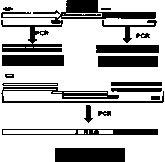CRISPR/Cas9 technology mediated down producing goat VEGF gene fixed-point knock-in method
A cashmere goat, gene technology, applied in the field of animal molecular breeding, can solve the problem of lack of integrity
- Summary
- Abstract
- Description
- Claims
- Application Information
AI Technical Summary
Problems solved by technology
Method used
Image
Examples
Embodiment 1
[0115] Example 1: Design of gRNA based on cashmere goat CCR5 full-length genome sequence (Gene ID: 102178672) Design of gRNA based on target sequence is a basic requirement of CRISPR / Cas9 technology. For site-directed integration of foreign genes, the selection of target sequences is very important, which involves the normal growth and development of cells, embryos and individuals and the expression of foreign genes, so the selection of target sites is creative.
[0116] The present invention selects the cashmere goat CCR5 gene as the target site, and not only refers to the literature data, but also conducts sequence characteristic analysis on the cashmere goat CCR5 full-length genome sequence (Gene ID: 102178672). The first exon of the cashmere goat CCR5 gene is short, only 112bp, the second exon is longer, 1312bp, and the start codon is on the second exon, so the present invention is based on the second exon of CCR5. Sequences Four gRNAs (gRNA1, gRNA2, gRNA3 and gRNA4) with ...
Embodiment 2
[0117] Example 2: Construction of gRNA expression vector
[0118] The construction of gRNA expression vector requires corresponding originals, including promoter, gRNA sequence and backbone sequence, transcription termination signal, etc., which constitute a transcription cassette of gRNA sequence and backbone sequence. Therefore, the construction of gRNA expression vector requires creativity.
[0119] The schematic diagram of the structure of the gRNA plasmid designed in the present invention is shown in Figure 2, including the U6 promoter, gRNA and its backbone sequence and termination signal sequence. First follow figure 1 As shown, the 5'-end (318bp) fragment of gRNA and the 3'-end (117bp) fragment of gRNA were obtained by overlapping PCR, and finally a 455bp fragment encoding the gRNA and its backbone sequence was obtained (Figure 8). Then, using the gRNA vector as the basic backbone, an expression vector pCCR5-gRNAs that includes U6 promoter, gRNA and its backbone seq...
Embodiment 3
[0123] Example 3: Detection of gRNA validity
[0124] The pCCR5-gRNA1, pCCR5-gRNA2, pCCR5-gRNA3 and pCCR5-gRNA4 were co-transfected into CFFCS with the hCas9 vector by electroporation, respectively. After 48 h, the cellular genomic DNA was extracted. The DNA extraction steps were completed according to the instructions of the Wizard Genomic DNA Purification Kit.
[0125] Use specific primers (Table 2) designed according to the sequences on both sides of the CCR5-1, CCR5-2, CCR5-3 and CCR5-4 sites for PCR amplification. The PCR reaction system is LATaqTM II 25 μL, upstream primers (10uM / L ) 2μL, downstream primer (10uM / L) 2μL, template 2μL, d3H2O 19μL. PCR reaction conditions: 95°C 5min; 95°C 1min, 57°C 30sec, 72°C 45sec, 33 cycles; 72°C 10min, 16°C 30min. Fragments containing sgRNA target sites were amplified from the cashmere goat genome, detected by electrophoresis, and the target fragments were recovered and purified by gel using the GeneJET Gel Extraction Kit.
[0126] T...
PUM
 Login to View More
Login to View More Abstract
Description
Claims
Application Information
 Login to View More
Login to View More - R&D
- Intellectual Property
- Life Sciences
- Materials
- Tech Scout
- Unparalleled Data Quality
- Higher Quality Content
- 60% Fewer Hallucinations
Browse by: Latest US Patents, China's latest patents, Technical Efficacy Thesaurus, Application Domain, Technology Topic, Popular Technical Reports.
© 2025 PatSnap. All rights reserved.Legal|Privacy policy|Modern Slavery Act Transparency Statement|Sitemap|About US| Contact US: help@patsnap.com



